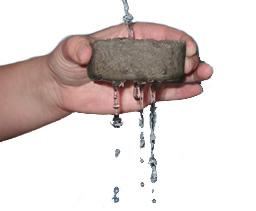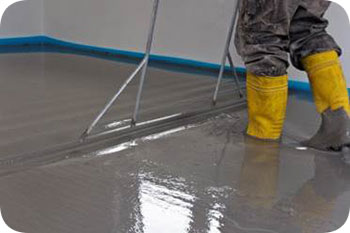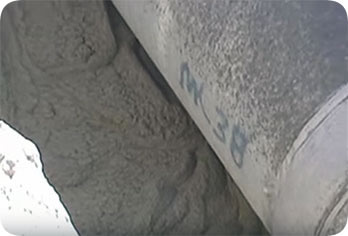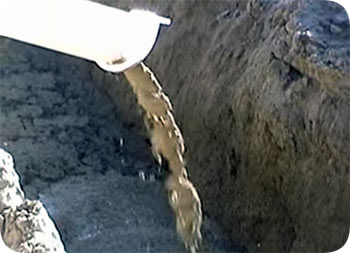- info@throop.com
- + 800-796-0285
 Cellular foam concrete is a lightweight concrete. It is produced by substituting some or all of the aggregate particles with a uniform cellular structure of air cells (voids) found in standard concretes. The air cells are produced mechanically using special liquid foam concentrates that are precisely controlled. It meets the standard ASTM C869. View Wikipedia definition on foam concrete.
Cellular foam concrete is a lightweight concrete. It is produced by substituting some or all of the aggregate particles with a uniform cellular structure of air cells (voids) found in standard concretes. The air cells are produced mechanically using special liquid foam concentrates that are precisely controlled. It meets the standard ASTM C869. View Wikipedia definition on foam concrete.
The foam is produced by diluting a liquid concentrate with water, then pressurizing it with air and forcing it through a conditioning nozzle. The foam is then blended with a base mix consisting of cement, fly ash, water and sometimes aggregate. This causes the base mix to expand and become lighter. The air bubbles hold their shape until the cement permanently hydrates trapping the air in the material. The density and strength of the material is a function of the mix design which can change with each and every job.
High capacity production is easily accomplished with Cellular Concrete.
What is Cellular Foam Concrete Used For?
Cellular foam concrete can be used in many different applications. Because the density of the concrete can be controlled there is a broad range of applications such as:
 Grouting Tunnels – A low-density grout containing cement, lightweight Cellular Foam Concrete and fly ash can be used for grouting tunnels saving thousands of dollars in cement costs alone.
Grouting Tunnels – A low-density grout containing cement, lightweight Cellular Foam Concrete and fly ash can be used for grouting tunnels saving thousands of dollars in cement costs alone.- Soil Stabilization – When poor subsoil conditions exist, cellular concrete can be used to create a strong base, while reducing burden on subsoils.
- Bridge/Overpass Abutment Fill – Because cellular does not need compaction, it won’t compress over time, creating a “dip” in a bridge or overpass approach. Additionally, lateral loads against the existing abutment are greatly reduced.
- Utility Trench Fills – Encasing utilities with cellular concrete greatly reduces the chance of pipe deflection because cellular is free flowing and doesn’t need compaction. Also, cellular concrete can be easily excavated by hand should the need arise.
- Roof Decks/Floor Decks – Provides thermal and acoustical insulative advantages.
- Precast Blocks/Walls – Although not applicable for all precast blocks and walls, cellular concrete can be designed to decrease weight, cost, and still provide reasonable strength.
 Annular Space Fill or Grouting – In sliplining projects cellular concrete is often specified for filling the annular space because it reduces the potential for pipe flotation, and also because it can be pumped at very low pressure and flow long distances. It is perfect for micro-tunneling and jack and bores.
Annular Space Fill or Grouting – In sliplining projects cellular concrete is often specified for filling the annular space because it reduces the potential for pipe flotation, and also because it can be pumped at very low pressure and flow long distances. It is perfect for micro-tunneling and jack and bores.- Sub Slabs Fill Material – Cellular concrete can be produced at very high rates. Because it doesn’t need compaction, sub slab fills can be accomplished quickly, speeding the construction process. Additionally, the insulative properties of cellular concrete can increase energy efficiency.
- Architectural/Decorative Precast – By using cellular concrete, shipping costs and material input costs can be reduced.
- Pipe and Tunnel Abandonment – Cellular concrete can be produced cost effectively, pumps easily and flows long distances, making it an excellent choice for these types of applications. Cellular concrete is perfect for encasing pipelines and large diameter tunnels.
- Flowable Fill (CLSM) and Geofoam – Any application where flowable fill or geofoam blocks are being used, cellular concrete is an excellent alternative, and in many cases the preferred material of choice.
- Raised lightweight platforms – Pervious cellular lightweight concrete is an appropriate geotechnical solution wherever low density, free-draining material is needed. Cellular lightweight concrete that is permeable, open-celled, low-density concrete able to stabilize soil without disturbing or redirecting natural water flow.
- Tunnel Backfill – When tunnels are being constructed Cellular lightweight concrete can be used to protect the workers during construction.
- Underwater Placement – Cellular concrete fills voids caused by erosion, protects against marine borers and can be used to encapsulate timber piles.
- Abandonment Fills – Cellular concrete fills abandoned tunnels, water lines, gas lines and abandoned sewer lines.
- Load Reducing Backfills – Retaining walls, MSE walls, deep foundation walls, abutment walls, bridge approaches, embankment fills, above underground structures, the need to replace weak native soil and open cut trenches
Features of Cellular Foam Concrete
 Low Density/Lightweight – Horizontal or vertical load reduction can be achieved without reducing strength or stability by using Cellular Foam Concrete.
Low Density/Lightweight – Horizontal or vertical load reduction can be achieved without reducing strength or stability by using Cellular Foam Concrete.- Cellular Foam Concrete has High Load Bearing Capacity – Lightweight, yet stronger than soils or compacted fills.
- Permeable and Non-Permeable – Cellular Foam Concrete is more flexible and helps to solve specific construction challenges.
- Easily Pumpable – High air content makes Cellular Foam Concrete easy to pump long distances at low pressures.
- Highly Flowable – Self-leveling and will flow into and fill any void.
- No Compaction needed – No compaction is necessary when using Cellular Foam Concrete. This product can be used when future settlement cannot be tolerated.
- Insulating Properties – Cellular Foam Concrete provides good insulating qualities.
- Absorbs Energy – As cellular concrete is compressed during impact, resistance increases and kinetic energy is absorbed.
